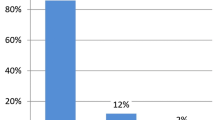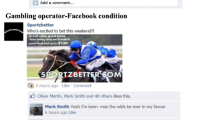Abstract
Based upon a previous qualitative study a questionnaire ascertaining adolescents’ awareness of gambling advertisements and their impact upon their behavior was developed and administered to 1,147 youth between the ages of 12 and 19. The findings suggest that almost all youth report being exposed to advertising with many individuals indicating being bombarded with messages, especially through pop-up ads viewed on the Internet. Sixty-one percent of youth reported receiving spam gambling advertisements by e-mail and 96% had seen TV advertisements for gambling. The underlying perceived message is that winning is easy, the chance of winning is high and that gambling is an easy way to become wealthy. While most youth are dismissive of the messages and are aware of the risks associated with gambling, a large percentage of youth report that these messages prompt them to gamble. Rather than inciting non-gamblers to begin gambling, advertisements appear to serve the function of maintaining established gambling habits and were particularly problematic to youth with gambling problems. Gender and developmental trends were noted.
Similar content being viewed by others
References
American Psychiatric Association (APA) (1994). Diagnostic and Statistical Manual of Mental Disorders-IV. Washington, DC: American Psychiatric Association.
Binde, P. (2009) Exploring the impact of gambling advertising: an interview stuydy of problem gamblers. Int J Ment Health Addict.
Burke, R. R., & Srull, T. K. (1989). Competitive interference and consumer memory for advertising. Journal of consumer research, 15, 55–68. doi:10.1086/209145.
De Pelsmacker, P., Geuens, M., & Anckaert, P. (2002). Media context and advertising effectiveness: the role of context appreciation and context/ad similarity. Journal of Advertising, 31, 49–61.
Derevensky, J. (2008). Youth gambling problems: the hidden addiction. In Y. Kaminer & O. G. Buckstein (Eds.), Adolescent substance abuse: Psychiatric comorbidity and high risk behaviors. New York: Haworth.
Derevensky, J. L., Gupta, R., Messerlian, C. (2007). The Effects of Gambling Advertising Questionnaire (EGAQ). Montreal: McGill University.
Derevensky, J. L., Gupta, R., Messerlian, C., Mansour, S. (2009). The impact of gambling advertisements on child and adolescent behaviors: A qualitative analysis. McGill University.
Ellickson, P. L., Collins, R. L., Hambarsoomians, K., & McCaffrey, D. F. (2005). Does alcohol advertising promote adolescent drinking? Results from a longitudinal assessment. Addiction, 100, 235–246. doi:10.1111/j.1360-0443.2005.00974.x.
Faber, R. J., Lee, M., & Nan, X. (2004). Advertising and the consumer information environment online. American Behavioral Scientist, 48, 447–466. doi:10.1177/0002764204270281.
Feeney, D. (2004). Responsible gaming advertising: A critical review. Minnesota: Minnesota State Lottery.
Felsher, J. R., Derevensky, J. L., & Gupta, R. (2004). Lottery playing amongst youth: implications for prevention and social policy. Journal of Gambling Studies, 20, 127–153. doi:10.1023/B:JOGS.0000022306.72513.7c.
Fisher, S. (2000). Developing the DSM-IV-MR-J to identify adolescent problem gambling in non-clinical populations. Journal of Gambling Studies, 16(2/3), 253–274. doi:10.1023/A:1009437115789.
Gillespie, M., Derevensky, J., & Gupta, R. (2007). The utility of outcome expectancies in the prediction of adolescent gambling behavior. Journal of Gambling Issues, 19, 69–85.
Griffiths, M. D. (2005). Does gambling advertising contribute to problem gambling? International Journal of Mental Health and Addiction, 3(2), 15–25.
Gupta, R., & Derevensky, J. (1996). The Gambling Attitude Questionnaire. Montreal: McGill University.
Gupta, R., & Derevensky, J. (2008). A treatment approach for adolescents with gambling problems. In M. Zangeneh, A. Blaszczynski & N. Turner (Eds.), In the pursuit of winning: Problem gambling theory, research and treatment, pp. 271–290. New York: Springer Books.
Igartua, J. J., Cheng, L., & Lopes, O. (2003). To think or not to think: two pathways towards persuasion by short films on AIDS prevention. Journal of Health Communication, 8, 513–528. doi:10.1080/716100420.
Jacobs, D. F. (2004). Youth gambling in North America: Long term trends and future prospects. In J. L. Derevensky & R. Gupta (Eds.), Gambling problems in youth: Theoretical and applied perspectives, pp. 1–24. New York: Kluwer Academic.
Korn, D. A., Hurson, T., & Reynolds, J. (2005). Final report: Commercial gambling advertising: Possible impact on youth knowledge. attitudes, beliefs and behavioral intentions: Ontario Problem Gambling Research Centre.
Maddock, R. C., & Fulton, R. L. (1996). Marketing to the mind: Right brain strategies for advertising and marketing. Westport, CT: Quorum Books.
Martin, S. E., Snyder, L. B., Hamilton, M., Fleming-Milici, F., Slater, M. D., Stacy, A., et al. (2002). Alcohol advertising and youth. Alcoholism, Clinical and Experimental Research, 26, 900–906.
McQuail, D., & Windahl, S. (1993). Communication models for the study of mass communication. London: Longman.
Monagahan, S., Derevensky, J., & Sklar, A. (2008). Impact of ambling advertisements and marketing on children and adolescents: policy recommendations to minimise harm. Journal of Gambling Issues, 22, 252–274.
Monaghan, S., & Derevensky, J. (2008). An appraisal of the impact of the depiction of gambling in society on youth. International Journal of Mental Health and Addiction, 6, 1557–1574.
Najavits, L. M., Grymala, L. D., & George, B. (2003). Can advertising increase awareness of problem gambling? A statewide survey of impact. Psychology of Addictive Behaviors, 17, 324–327. doi:10.1037/0893-164X.17.4.324.
Noel, H. (2006). The spacing effect: enhancing memory for repeated marketing stimuli. Journal of Consumer Psychology, 16, 306–320. doi:10.1207/s15327663jcp1603_12.
Petty, R. E., & Cacciopo, J. T. (1986). Communication and persuasion: Central peripherical routes to attitude change. New York: Springer-Versa.
Saffer, H. (2002). Alcohol advertising and youth. Journal of Studies on Alcohol, 63, 173–181.
Steenkamp, J. E. M., & Baumgartner, H. (1992). The role of optimum stimulation level in exploratory consumer behavior. Journal of Consumer Research, 19, 434–448. doi:10.1086/209313.
Stout, P. A., & Burda, B. L. (1989). Zipped commercials: are they effective? Journal of Advertising, 18, 23–32.
Whittler, T. E., & Spira, J. S. (2002). Model's race: a peripheral cue in advertising messages? Journal of Consumer Psychology, 12, 291–301. doi:10.1207/15327660260382333.
Wiseman, C. V., Sunday, S. R., & Becker, A. E. (2005). Impact of the media on adolescent body image. Child and Adolescent Psychiatric Clinics of North America, 14, 453–471. doi:10.1016/j.chc.2005.02.008.
Wyllie, A., Zhang, J. F., & Casswell, S. (1998). Responses to televised alcohol advertisements associated with drinking behavior of 10-17-year-olds. Addiction, 93, 361–371. doi:10.1046/j.1360-0443.1998.9333615.x.
Youn, S., Faber, R. J., & Shah, D. V. (2000). Restricting gambling advertising and the third-person effect. Psychology and Marketing, 17, 633–649. doi:10.1002/(SICI)1520-6793(200007)17:7<633::AID-MAR4>3.0.CO;2-B.
Author information
Authors and Affiliations
Corresponding author
Additional information
This research was supported by a grant from the Fonds de recherche sur la société et la culture, Ministry of Health and Social Services, Quebec
Rights and permissions
About this article
Cite this article
Derevensky, J., Sklar, A., Gupta, R. et al. An Empirical Study Examining the Impact of Gambling Advertisements on Adolescent Gambling Attitudes and Behaviors. Int J Ment Health Addiction 8, 21–34 (2010). https://doi.org/10.1007/s11469-009-9211-7
Received:
Accepted:
Published:
Issue Date:
DOI: https://doi.org/10.1007/s11469-009-9211-7




